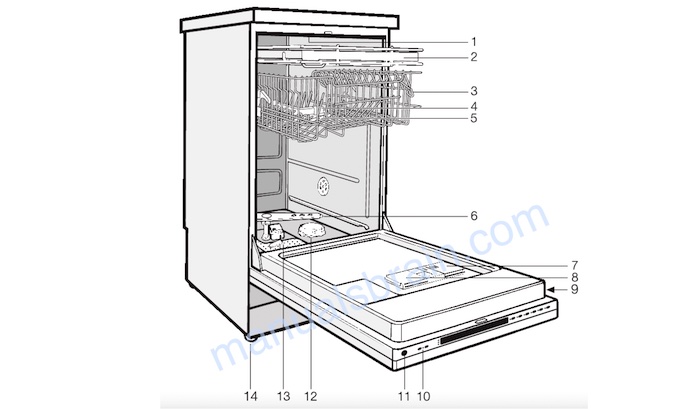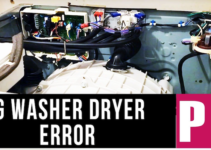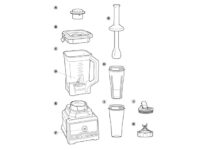Miele produces and designs premium dishwashers manufactured in Germany to offer the highest level of performance. The dishwashers are an excellent reflection of the company slogan, which means “forever better”. Indeed they boast premium features plus exceptional durability.
Whether you’re just using the dishwasher for the first time or want to enjoy all it has to offer, it’s essential to familiarize yourself with the component to understand the dishwasher’s operation.
This article will reveal the different components of the Miele dishwasher through a diagram and explains their roles and functions.
Miele Dishwasher Parts Diagram
Miele produces a broad range of dishwashers from mid to high range. They come in different categories and are designed with sustainability and hygiene. However, the components are similar across all categories with few distinctive features. The only primary difference is aesthetics.
Below is a diagram showing the typical components of a Miele dishwasher:

- Upper spray arm (not visible)
- Cutlery tray
- Upper basket
- Water feed for middle spray arm
- Middle spray arm
- Lower spray arm
- Rinse aid reservoir
- Dual-compartment detergent dispenser
- Data plate
- Control panel
- In-operation control light
- Salt reservoir
- Filter combination
- Four height adjustable screw
Miele Dishwasher Parts Explained
The components of the Miele dishwasher can be categorized into internal and external, and the tub and interior parts. The internal parts work together to form the powerful system of keeping the dishes clean load after load.
The tub and interior parts are necessary to maintain the dishwasher as they combine water, detergent, and heat with cleaning your dishes.
It’s crucial to learn the unique roles of each component to understand how they work together to clean your dishes. Follow along as we reveal the function of the parts.
Racks
While the dishwasher’s jets deliver cleaning power directly to your dishes, the racks serve as the loading area holding the items.
Most Miele dishwashers have numerous shelves (about 2-3) with rows of tines storing the things in place during a wash or dry cycle. They also frequently have a basket for silverware to hold cutlery.
Spray Arms
The spray arm works when the circulation pump pushes strong streams of water through them. The number of spray arms in a Miele dishwasher depends on the model.
A typical dishwasher will have about 2-3 rotating wash arms, with one arm located beneath the upper rack and the other below the bottom shelf. Both activate immediately water from the circulation pump flows through into the arms.
Heating Elements
A typical Miele dishwasher usually has a heating element at the base of the dishwasher tub. The heating elements are responsible for increasing water temperature during a wash cycle session to remove built-in residue.
They also heat the air inside the dishwasher to dry the machine during the drying cycle. A heating element is a coil that heats the water for washing and the air for drying.
Circulation Pump
The circulation pump in a dishwasher helps force the water into the dishwasher tub and pass the spray arms. During the process, the circulation motor improves the water pressure to enhance the arm’s rotating motion, providing forceful streams to remove food away from the surface of the plates.
Detergent Dispenser
Before each wash cycle begins, your detergent and rinse aid are placed in your dispenser. The detergent dispenser is typically located inside the dishwasher door.
It resembles a little rectangular container with a lid and typically has a distinct rinse aid chamber. It has two different compartments: one for the rinse aid and the other for detergent.
When the cycle begins, the timers dispense each solution at the correct time. The detergent dispenser’s interior can accumulate cleaning solution over time, so cleaning the chamber as needed is crucial by wiping down any leftovers with a damp cloth.
Filtration system
Every dishwasher has a filter, which you should occasionally check. Warm water can be used to clean some that are removable. Typically, the lower rack of the tub’s bottom corner houses your dishwasher’s filter.
The filter will funnel out the contaminated water and prevent the pump from being clogged with large food particles. When your dishes come out dirty, or the water won’t drain properly, they indicate that your filter needs cleaning.
Water Inlet Valve
Your dishwasher’s water inlet valve is crucial for managing water entering the washer tub. It is typically found inside a dishwasher. It frequently opens and closes to regulate the volume of water used to fill the washer tub during a wash cycle.so it’s crucial to consider replacing the valve if you observe wear or damage to avoid further complications.
Water Supply And Drain Hose
The water supply and drain hose are underrated components of the dishwasher. They help convey and remove water from the machine tub during a wash session. The water supply hose passes water into the tub before the wash cycle, while the drain hose removes it afterwards.
During installation, the water supply hose is connected to your home’s hot water supply line. The drain hose is attached to either the drain pipe or the garbage disposal. The hoses are then connected through the cabinetry and fastened using fittings.





